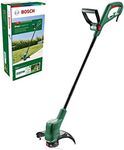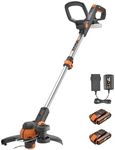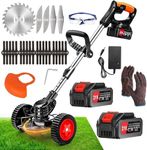Buying Guide for the Best Grass Trimmers
Choosing the right grass trimmer can make a big difference in maintaining your lawn and garden. The right trimmer will help you keep your outdoor space looking neat and tidy with minimal effort. When selecting a grass trimmer, it's important to consider several key specifications to ensure you get the best fit for your needs. Understanding these specs will help you make an informed decision and find a trimmer that suits your yard size, type of vegetation, and personal preferences.Power SourceThe power source of a grass trimmer can be electric (corded or cordless) or gas-powered. Electric trimmers are generally lighter, quieter, and require less maintenance. Corded models offer unlimited runtime but are limited by the length of the power cord, making them suitable for smaller yards. Cordless models provide more mobility but have limited battery life, which is ideal for medium-sized yards. Gas-powered trimmers are more powerful and can handle larger areas and tougher vegetation, but they are heavier, noisier, and require more maintenance. Choose based on the size of your yard and the type of vegetation you need to trim.
Cutting WidthThe cutting width of a grass trimmer refers to the diameter of the cutting swath. This determines how much grass or weeds the trimmer can cut in a single pass. A larger cutting width (14 inches or more) is suitable for larger areas, as it allows you to cover more ground quickly. A smaller cutting width (10-12 inches) is better for precision work in smaller or more intricate areas. Consider the size of your yard and the level of detail you need when choosing the cutting width.
WeightThe weight of a grass trimmer affects how easy it is to handle and maneuver. Lighter trimmers (under 10 pounds) are easier to use for extended periods and are ideal for smaller yards or for users who may have difficulty handling heavier equipment. Heavier trimmers (over 10 pounds) are often more powerful and suitable for larger areas or tougher vegetation but can be more tiring to use. Consider your physical strength and the size of the area you need to trim when selecting the weight of your trimmer.
Shaft TypeGrass trimmers come with either a straight or curved shaft. Straight shaft trimmers are generally longer and provide better reach, making them suitable for trimming under bushes and around obstacles. They are also more comfortable for taller users. Curved shaft trimmers are shorter and lighter, offering better balance and ease of use for shorter users or for trimming around flower beds and other tight spaces. Choose the shaft type based on your height and the specific areas you need to trim.
Line Feed SystemThe line feed system determines how the trimmer line is advanced during use. There are three main types: bump feed, automatic feed, and fixed line. Bump feed systems require you to tap the trimmer head on the ground to release more line, giving you control over the line length. Automatic feed systems release line as needed without any user intervention, offering convenience but potentially wasting line. Fixed line systems use pre-cut lengths of line that you manually replace, providing simplicity but requiring more frequent stops. Consider your preference for convenience versus control when choosing a line feed system.
AdjustabilityAdjustability features, such as adjustable handles and telescoping shafts, can enhance the comfort and usability of a grass trimmer. Adjustable handles allow you to find a comfortable grip, reducing strain on your hands and arms. Telescoping shafts let you adjust the length of the trimmer to suit your height, improving ergonomics and reducing back strain. Look for trimmers with these features if you plan to use the trimmer for extended periods or if multiple people of different heights will be using it.
















